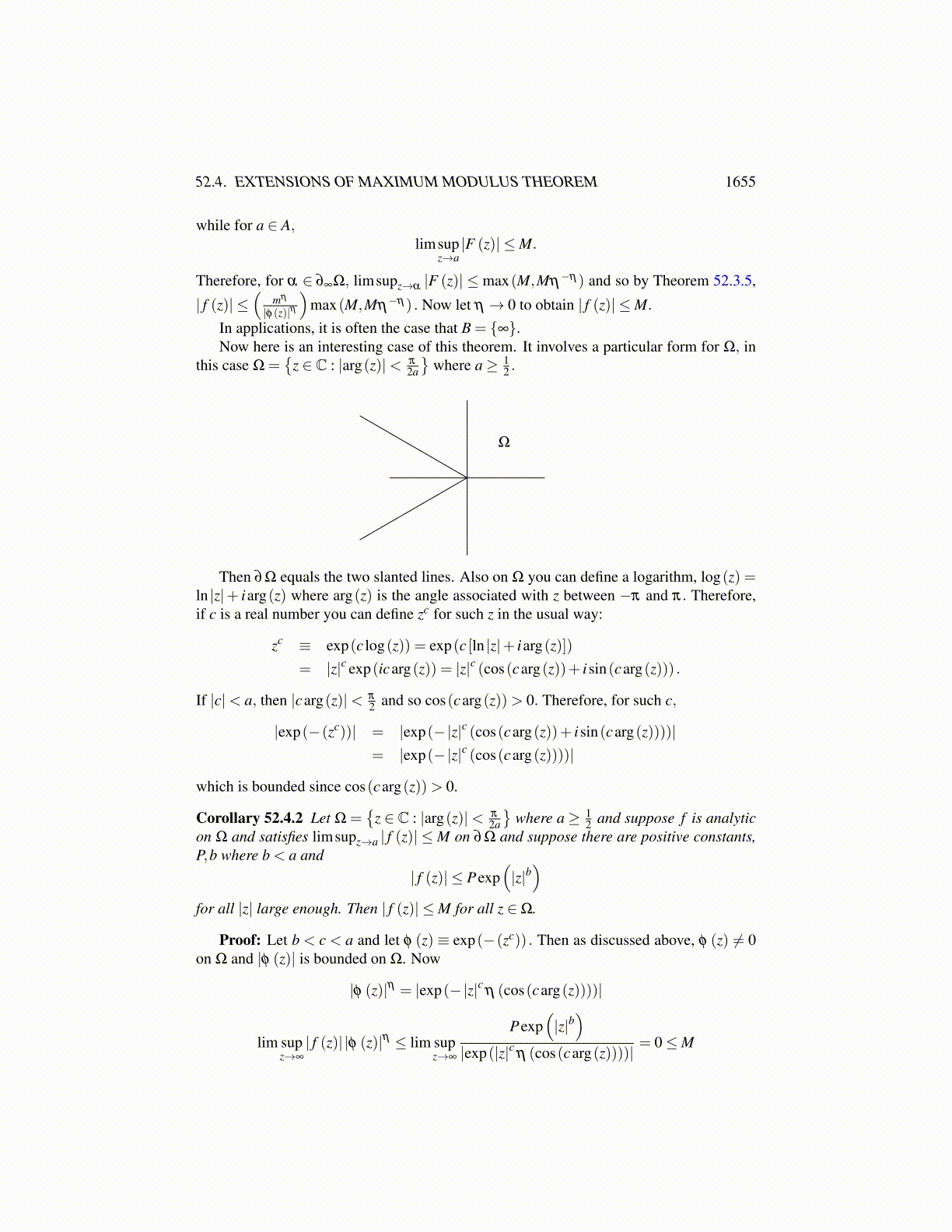
52.3. MAXIMUM MODULUS THEOREM 1655
52.3 Maximum Modulus TheoremHere is another very significant theorem known as the maximum modulus theorem whichfollows immediately from the open mapping theorem.
Theorem 52.3.1 (maximum modulus theorem) Let Ω be a bounded region and let f : Ω→C be analytic and f : Ω→ C continuous. Then if z ∈Ω,
| f (z)| ≤max{| f (w)| : w ∈ ∂Ω} . (52.3.3)
If equality is achieved for any z ∈Ω, then f is a constant.
Proof: Suppose f is not a constant. Then f (Ω) is a region and so if z ∈Ω, there existsr > 0 such that B( f (z) ,r) ⊆ f (Ω) . It follows there exists z1 ∈ Ω with | f (z1)| > | f (z)| .Hence max
{| f (w)| : w ∈Ω
}is not achieved at any interior point of Ω. Therefore, the point
at which the maximum is achieved must lie on the boundary of Ω and so
max{| f (w)| : w ∈ ∂Ω}= max{| f (w)| : w ∈Ω
}> | f (z)|
for all z ∈Ω or else f is a constant. This proves the theorem.You can remove the assumption that Ω is bounded and give a slightly different version.
Theorem 52.3.2 Let f : Ω→C be analytic on a region, Ω and suppose B(a,r)⊆Ω. Then
| f (a)| ≤max{∣∣∣ f (a+ reiθ
)∣∣∣ : θ ∈ [0,2π]}.
Equality occurs for some r > 0 and a ∈ Ω if and only if f is constant in Ω hence equalityoccurs for all such a,r.
Proof: The claimed inequality holds by Theorem 52.3.1. Suppose equality in the aboveis achieved for some B(a,r) ⊆ Ω. Then by Theorem 52.3.1 f is equal to a constant, w onB(a,r) . Therefore, the function, f (·)−w has a zero set which has a limit point in Ω andso by Theorem 51.5.3 f (z) = w for all z ∈Ω.
Conversely, if f is constant, then the equality in the above inequality is achieved for allB(a,r)⊆Ω.
Next is yet another version of the maximum modulus principle which is in Conway[32]. Let Ω be an open set.
Definition 52.3.3 Define ∂∞Ω to equal ∂Ω in the case where Ω is bounded and ∂Ω∪{∞}in the case where Ω is not bounded.
Definition 52.3.4 Let f be a complex valued function defined on a set S ⊆ C and let a bea limit point of S.
limsupz→a| f (z)| ≡ lim
r→0
{sup | f (w)| : w ∈ B′ (a,r)∩S
}.
The limit exists because {sup | f (w)| : w ∈ B′ (a,r)∩S} is decreasing in r. In case a = ∞,
lim supz→∞
| f (z)| ≡ limr→∞{sup | f (w)| : |w|> r,w ∈ S}